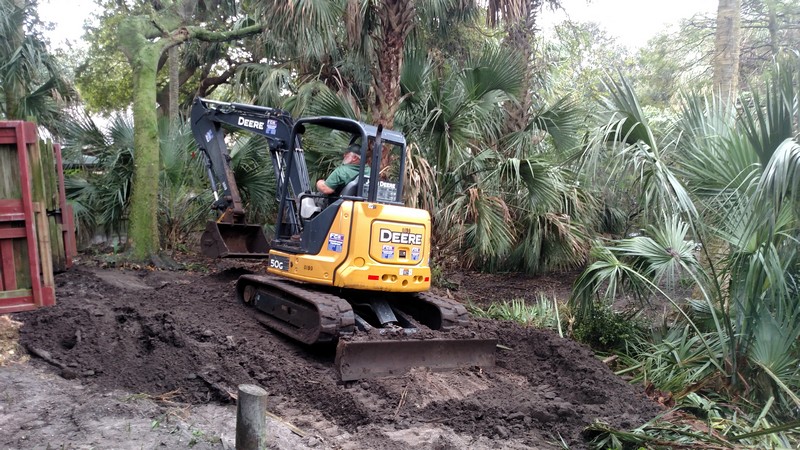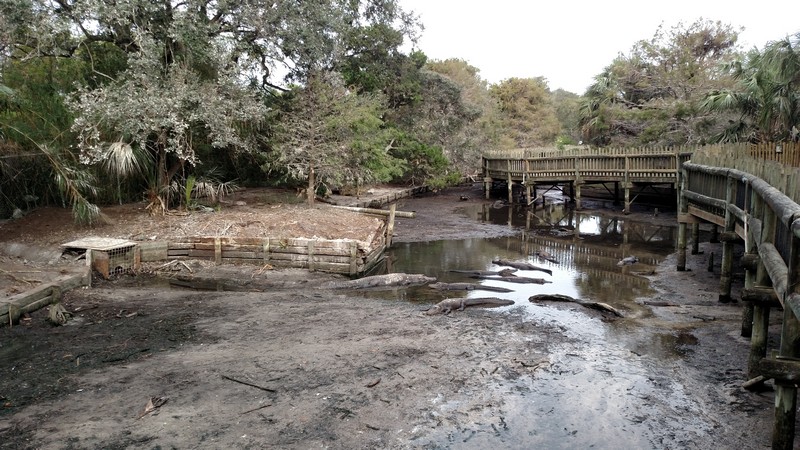
22 Jan Swamp Renovation and Beautification
By John Brueggen, Director and Gen Anderson, General Curator
For many years, visitors to the St. Augustine Alligator Farm have enjoyed the amazing phenomenon of native Florida wading birds choosing our alligator swamp boardwalk area as a roosting and nesting site. The protection afforded them against tree climbing predators, such as raccoons and possums, by non-tree climbing alligators is so valuable to the birds that they willingly accept the presence of hundreds of visitors to their private nesting trees. Due to the extensive amounts of acidic guano produced by Wood storks, rookery trees are quickly destroyed and 10 years is considered a long-term stork rookery. Our population has been here for 16 years, only because of our intensive habitat management to conserve the existing trees with supplemental sprinkling systems and an advance technology called air spading.
The habitat does experience considerable pressure from the birds, the alligators, and our zoo guests, and we must continue maintaining it for the benefit of all three. This past fall, we conducted a more comprehensive annual improvement plan by relocating the alligator feeding platform over a new submersible pumping system that will circulate, oxygenate, and help purify the water utilizing a parabolic screen filter. This is a novel and new application that is being studied by top research professionals both in scholarly research and by environmental improvement advocates. Along with the installation of this system, we reshaped the lake bottom, providing deeper water in some areas, as well as basking sites. Non-native and invasive plants were removed, while extensive planting of the appropriate species continues. This rehabilitation project exceeded $50,000 this year alone.
I’m super proud of everything our staff has done in the Swamp this year in a very tight time frame (we have to accomplish all of this before the birds come back to nest in February). It may look different, but I can promise the Native Swamp & Rookery will be healthier for it. Come this spring, the plants will fill back in, the Cypress trees will turn green again, the advanced filter system will clarify the water, and the birds will come back to nest. You won’t be disappointed in the work we have done. The habitat management we are doing for our 2 acre swamp is considered on the cutting edge by USFWS. They are closely monitoring our actions with excitement to see how our management can be used in other important rookeries throughout the southeast that are at risk.

Frank sat on this trackhoe for nearly 6 weeks straight.

The banks had to be extensively replenished since they were nearly non-existent and the trees were falling over into the swamp.

Work in progress. Thank you to our amazing, hard-working maintenance department!

Swamp was drained in order to rebuild the banks and deepen the depth. The old feeding platform was removed in order to minimize man-made structures along the west side.

A pathway had to be opened up for construction vehicles, but only one Cabbage palm was removed plus some ailing shrubbery. This area is in the process of being replanted.

Keeper staff are excited about the new alligator feeding platform! It is much safer for staff due to the ease of access and its structural integrity. Below the decking is the entry point for the filtration system.

The alligators pile all over each other on the basking islands. New feeding platform (staff only) is on the right next to the back side of Maximo’s enclosure. Man-made structures are placed close to one other in order to maximize naturalistic views in other angles.

Far north side of main Live oak island was no longer an island which allowed land predators, such as raccoons, access to the nesting birds. A channel was dug to reform the island and improve water quality.

Same location from opposite view. Interior fence line had to be replaced, banks rebuilt, and channel dug. Rye grass is growing to help the banks settle in and improve the soil. Additional trees and bushes will be planted.

Little lagoon now has replanted banks.

Oh no! The wading birds come with pros and cons for the alligators!

It is still a work in progress, but we know this swamp will blossom from this renovation! As of this post, the following flora have been planted and we can’t wait to see how they fill out!:
1 American sycamore
3 Florida flame Red maple
1 River birch
5 Cabbage palm
2 Red cedar
1 Southern magnolia
14 Wax myrtle
12 Elderberry
2 Simpson stopper
3 Buttonbush
3 Salt bush
2 Walter’s viburnum
2 Muscadine grapevine
14 Carolina jasmine vine
14 Coral honeysuckle vine
15 Fakahatchee grass
